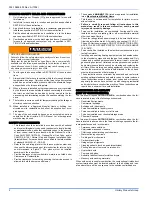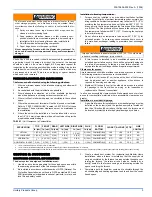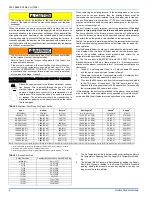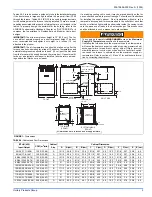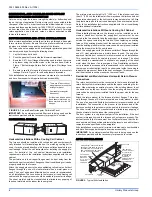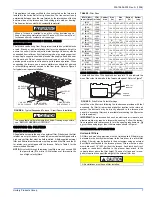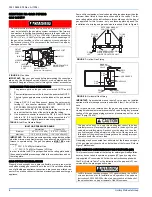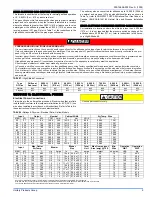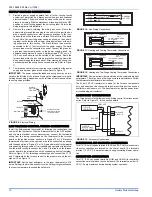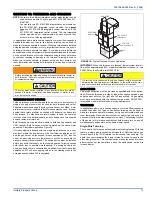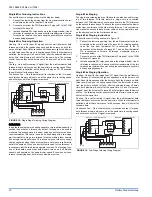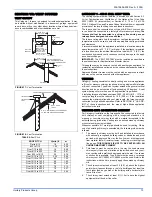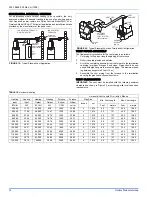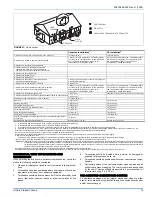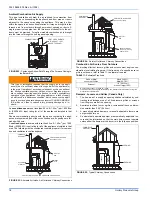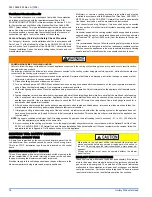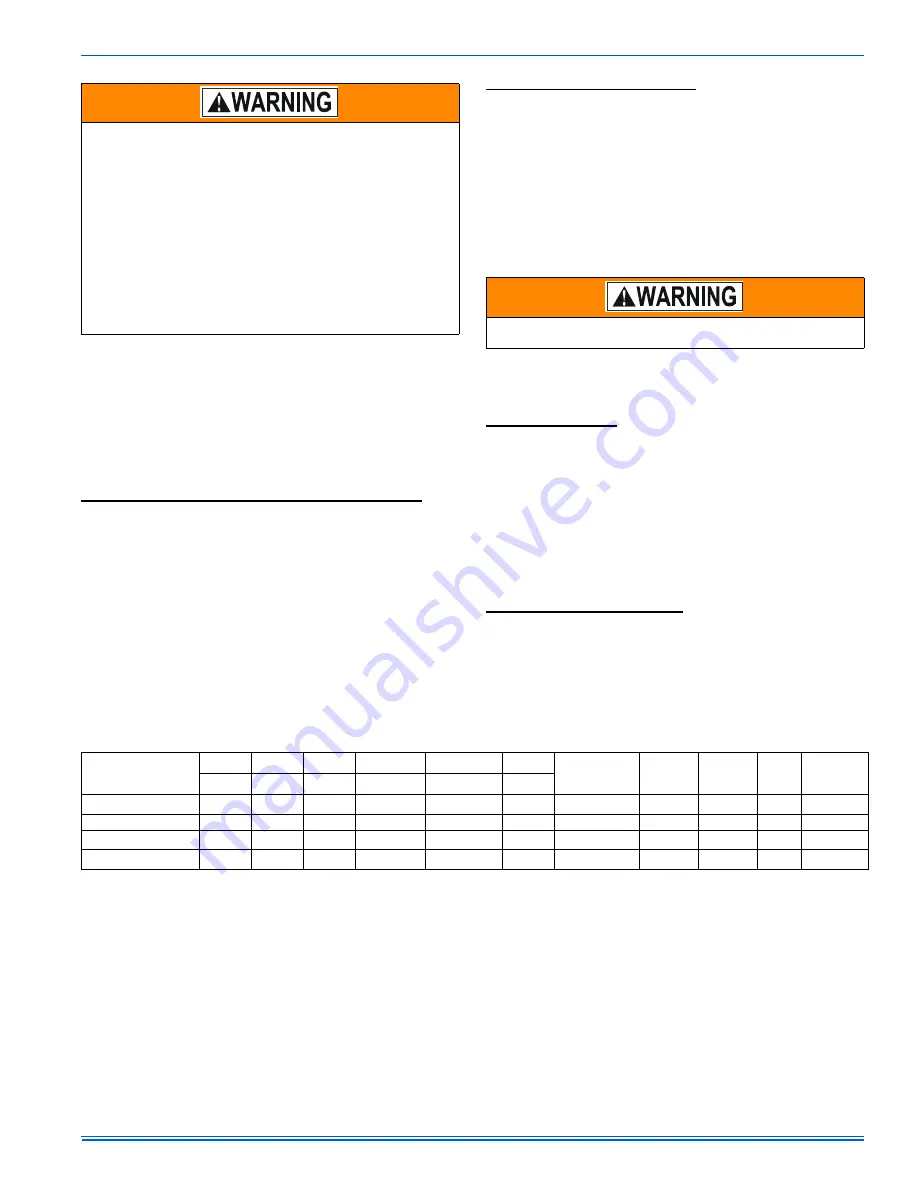
035-19656-003 Rev. A (1004)
Unitary Products Group
3
INSPECTION
As soon as a unit is received, it should be inspected for possible dam-
age during transit. If damage is evident, the extent of the damage
should be noted on the carrier’s freight bill. A separate request for
inspection by the carrier’s agent should be made in writing. Also, before
installation the unit should be checked for screws or bolts, which may
have loosened in transit. There are no shipping or spacer brackets
which need to be removed.
FURNACE LOCATION AND CLEARANCES
The furnace shall be located using the following guidelines:
1.
Where a minimum amount of air intake/vent piping and elbows will
be required.
2.
As centralized with the air distribution as possible.
3.
Where adequate combustion air will be available (particularly
when the appliance is not using outdoor combustion air).
4.
Where it will not interfere with proper air circulation in the confined
space.
5.
Where the outdoor vent terminal will not be blocked or restricted.
Refer to “VENT CLEARANCES” located in SECTION VII of these
instructions. These minimum clearances must be maintained in
the installation.
6.
Where the unit will be installed in a level position with no more
than 1/4” (6.4 mm) slope side-to-side and front-to-back to provide
proper condensate drainage.
Installation in freezing temperatures:
1.
Furnace shall be installed in an area where ventilation facilities
provide for safe limits of ambient temperature under normal oper-
ating conditions. Ambient temperatures may fall below 32° F (0° C)
providing the flue temperature does not fall below 260° F (127° C)
at any point in the flue pipe between the furnace and the chimney
or a B-Vent. The flue products will condense in the vent pipe if the
flue temperature falls below 260° F (127° C) causing the vent pipe
to deteriorate rapidly.
2.
Do not allow return air temperature to be below 55º F (13° C) for
extended periods. To do so may cause condensation to occur in
the main heat exchanger, leading to premature heat exchanger
failure.
3.
If this furnace is installed in an unconditioned space and an
extended power failure occurs, there will be potential damage to
the internal components. Following a power failure situation, do
not operate the unit until inspection and repairs are performed.
Clearances for access:
Ample clearances should be provided to permit easy access to the unit.
The following minimum clearances are recommended:
1.
Twenty-four (24) inches (61 cm) between the front of the furnace
and an adjacent wall or another appliance, when access is
required for servicing and cleaning.
2.
Eighteen (18) inches (46 cm) at the side where access is required
for passage to the front when servicing or for inspection or
replacement of flue/vent connections.
In all cases, accessibility clearances shall take precedence over clear-
ances for combustible materials where accessibility clearances are
greater.
Installation in a residential garage:
1.
A gas-fired furnace for installation in a residential garage must be
installed so the burner(s) and the ignition source are located not
less than 18 inches (46 cm) above the floor, and the furnace must
be located or protected to avoid physical damage by vehicles.
SECTION II: DUCTWORK
DUCTWORK GENERAL INFORMATION
The duct system’s design and installation must:
1.
Handle an air volume appropriate for the served space and within
the operating parameters of the furnace specifications.
2.
Be installed in accordance with standards of NFPA (National Fire
Protection Association) as outlined in NFPA pamphlets 90A and
90B (latest editions) or applicable national, provincial, or state, and
local fire and safety codes.
3.
Create a closed duct system. For residential and Modular Home
installations, when a furnace is installed so that the supply ducts
carry air circulated by the furnace to areas outside the space con-
taining the furnace, the return air shall also be handled by a
duct(s) sealed to the furnace casing and terminating outside the
space containing the furnace.
4.
Complete a path for heated or cooled air to circulate through the
air conditioning and heating equipment and to and from the condi-
tioned space.
The furnace area must not be used as a broom closet or for any
other storage purposes, as a fire hazard may be created. Never
store items such as the following on, near or in contact with the fur-
nace.
1. Spray or aerosol cans, rags, brooms, dust mops, vacuum
cleaners or other cleaning tools.
2. Soap powders, bleaches, waxes or other cleaning com-
pounds; plastic items or containers; gasoline, kerosene, ciga-
rette lighter fluid, dry cleaning fluids or other volatile fluid.
3. Paint thinners and other painting compounds.
4. Paper bags, boxes or other paper products
Never operate the furnace with the blower door removed. To
do so could result in serious personal injury and/or equipment
damage.
Improper installation in an ambient below 32ºF (0.0° C) could create
a hazard, resulting in damage, injury or death.
TABLE 1:
Unit Clearances to Combustibles
APPLICATION
TOP
FRONT
REAR
LEFT SIDE RIGHT SIDE
FLUE
FLOOR/
BOTTOM
CLOSET ALCOVE ATTIC
LINE
CONTACT
In. (cm) In. (cm) In. (cm)
In. (cm)
In. (cm)
In. (cm)
UPFLOW
1 (25.4)
6 (15.24)
0 (0.0)
0 (0.0)
3 (7.62)
1
1.
14-1/2” cabinet models only. All other units “0” clearance.
6 (15.24)
COMBUSTIBLE
YES
YES
YES
NO
UPFLOW B-VENT
1 (25.4)
3 (7.62)
0 (0.0)
0 (0.0)
0 (0.0)
1 (25.4)
COMBUSTIBLE
YES
YES
YES
NO
HORIZONTAL
3
2
2.
14-1/2” cabinet left airflow applications only. All other units and right hand airflow applications “0” clearance.
6 (15.24)
0 (0.0)
1 (25.4)
0 (0.0)
6 (15.24)
COMBUSTIBLE
NO
YES
YES
YES
3
3.
Line contact only permitted between lines formed by the intersection of the rear panel and side panel (top in horizontal position) of the furnace jacket and building joists, studs or framing.
HORIZONTAL B-VENT
0 (0.0)
3 (7.62)
0 (0.0)
1 (25.4)
0 (0.0)
1 (25.4)
COMBUSTIBLE
NO
YES
YES
YES
3


